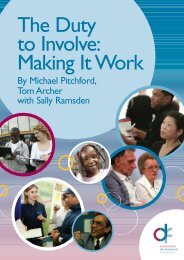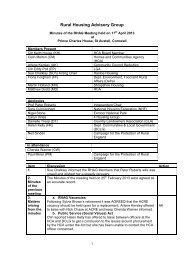Rapid Evidence Assessment of the Research ... - Rural Housing
Rapid Evidence Assessment of the Research ... - Rural Housing
Rapid Evidence Assessment of the Research ... - Rural Housing
You also want an ePaper? Increase the reach of your titles
YUMPU automatically turns print PDFs into web optimized ePapers that Google loves.
Executive Summary<br />
There is much discussion and argument about second homes that is not underpinned by a firm evidence base.<br />
A variety <strong>of</strong> definitions <strong>of</strong> second homes are in use. It is important when considering research, discussion or<br />
claims about second homes to be certain <strong>of</strong> <strong>the</strong> definition that has been applied. Some definitions are so wide<br />
that <strong>the</strong>y encompass all properties o<strong>the</strong>r than <strong>the</strong> principal residence <strong>of</strong> a household. This means that privately<br />
rented dwellings, including buy-to-let properties owned by a member <strong>of</strong> a household, can be included. The<br />
three key ‘<strong>of</strong>ficial’ sources <strong>of</strong> data, namely <strong>the</strong> Census, Survey <strong>of</strong> English <strong>Housing</strong> and Council Tax records<br />
have different definitions <strong>of</strong> second homes.<br />
According to <strong>the</strong> Census: Second residences are dwellings in permanent buildings which were known to be<br />
residences <strong>of</strong> people who had a more permanent address elsewhere and which were unoccupied on Census<br />
night. According to <strong>the</strong> Survey <strong>of</strong> English <strong>Housing</strong>: Second homes are properties, owned or rented by a<br />
household member, which are not <strong>the</strong> household’s main residence. However, properties which are <strong>the</strong> main<br />
residence <strong>of</strong> someone else, or which <strong>the</strong> owner intends to sell because <strong>the</strong>y have moved are not counted as<br />
second homes. According to Council Tax records: Second homes are furnished dwellings which are not <strong>the</strong><br />
sole or main residence <strong>of</strong> an individual.<br />
Although earlier surveys <strong>of</strong>ten depended on local case studies and detailed fieldwork, <strong>the</strong>re are now three<br />
accessible ‘<strong>of</strong>ficial’ sources <strong>of</strong> data on second homes. Given that (a) <strong>the</strong> Census is likely to underestimate <strong>the</strong><br />
number <strong>of</strong> second homes and it provides data only once every ten years and (b) <strong>the</strong> Survey <strong>of</strong> English <strong>Housing</strong><br />
is based on a sample <strong>of</strong> only 20,000 households and does not permit geographical breakdowns below regional<br />
level, <strong>the</strong> most comprehensive source <strong>of</strong> data is Council Tax records. This data does potentially embrace all<br />
residential property and can be analysed at local, regional and national levels. It is, fur<strong>the</strong>rmore, based on a<br />
fairly straightforward definition <strong>of</strong> second homes.<br />
A possible weakness <strong>of</strong> Council Tax data is that households have <strong>the</strong> option <strong>of</strong> deciding which <strong>of</strong> two<br />
residences is <strong>the</strong>ir second home. It is possible that households might choose which property to declare as <strong>the</strong>ir<br />
second home on <strong>the</strong> basis <strong>of</strong> minimising <strong>the</strong>ir aggregate Council Tax bill ra<strong>the</strong>r than <strong>the</strong> actual usage <strong>of</strong> <strong>the</strong> two<br />
dwellings. There are also suggestions that <strong>the</strong>re are circumstances in which it is advantageous to register<br />
second homes as small businesses and pay business rates instead <strong>of</strong> Council Tax. All <strong>of</strong> <strong>the</strong>se factors might<br />
mean that Council Tax records can underestimate <strong>the</strong> number <strong>of</strong> second homes. Whilst <strong>the</strong>re are claims, <strong>the</strong>re<br />
is no substantial empirical evidence that has been identified, to suggest that such activity is prevalent.<br />
Indeed, Council Tax data suggests that <strong>the</strong>re were about 240,000 second homes in England in 2006. This is<br />
comparable to <strong>the</strong> Survey <strong>of</strong> English <strong>Housing</strong> estimate <strong>of</strong> 241,000 second homes in England in 2006/7,<br />
representing a rise <strong>of</strong> about 20 per cent over <strong>the</strong> past decade.<br />
International evidence shows that <strong>the</strong> concept <strong>of</strong> second homes varies from country to country, but despite<br />
problems <strong>of</strong> comparability, it is clear that second home ownership is much higher in some European countries<br />
than it is in England.<br />
More than forty per cent <strong>of</strong> all second homes in England are in <strong>the</strong> South West and London and <strong>the</strong>re are<br />
significant concentrations in Cumbria, Northumberland, North Yorkshire, coastal East Anglia and parts <strong>of</strong> <strong>the</strong><br />
south coast. As well as concentrations <strong>of</strong> second homes in attractive rural areas <strong>the</strong>re are large numbers <strong>of</strong><br />
second homes in urban areas, especially parts <strong>of</strong> London. In ten local authorities more than seven per cent <strong>of</strong><br />
<strong>the</strong> housing stock consisted <strong>of</strong> second homes in 2006. There is limited and patchy research evidence on <strong>the</strong><br />
concentration <strong>of</strong> second homes at sub-local authority level.<br />
9






